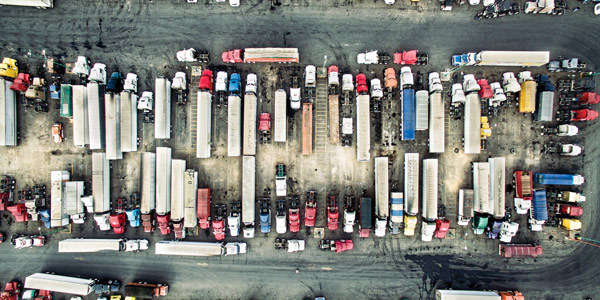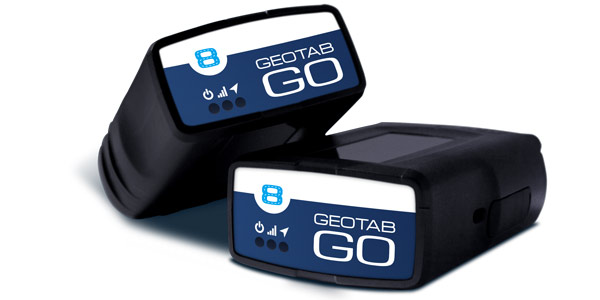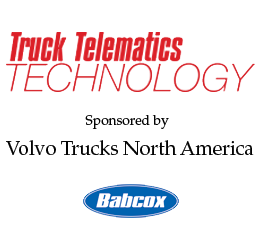
The ins and outs of trailer telematics

Fleet efficiencies can be greatly improved by technology. Savvy fleet managers are learning how to leverage trailer telematics to their advantage.
Location monitoring
“The most basic/fundamental reason for anyone to implement trailer tracking is for location. Where a trailer is, where it has been, and where it is going are critical pieces of information for fleet operations,” says Ryan Driscoll, marketing director for GPS Insight.
He went onto explain that there are two major areas of focus in terms of location: asset utilization and yard location. Asset utilization is important because trailers and chassis need to be measured for utilization to move them around an organization as needed or identify areas that need more assets, etc. Utilization is by far the greatest need GPS Insight sees today, Driscoll added.
“How a company can keep trailers full and keep them moving to generate revenue is the focus,” he says. “Yard location is an important use case for trailer tracking. Many fleets do this with RFID, but it only tells if the trailer is in the yard, not where in the yard. This saves drivers time by letting them know where they can find it.”
Driscoll goes on to say that sensors can be extremely valuable on trailers. “We find that the most commonly used are door open, door closed and temperature sensors,” he says. “Knowing when the door is open or closed can tell if items are being stolen or when the trailer is actually in use. In addition, you can monitor temperature of the trailer to ensure contents are properly transferred. Measuring the run-time of the refrigerated unit will allow for better preventative maintenance also.
“‘Stop Verification’ using geofences or landmarks will verify drops and pickups and ensure there are no unauthorized stops along the way, helping to identify possible theft situations,” he adds. “It can also help determine dwell time at customer locations and/or ports. Knowing where a trailer is might be enough to know load status, but in the case where it isn’t enough, we have integrations in place with companies like MacroPoint and FourKites that do load tracking. Using our GPS devices, load-tracking software will let the customer know if each load is going to be on time, behind or ahead of schedule.”
If the end-users work with their telematics provider, Driscoll adds, there is very little integration needed.
“Most of the platforms cover the bases for what is needed to effectively manage trucks and trailers,” he says. “If tracking loads in important, integrating with a load tracking company is simple to set up as well. Toll management, which uses telematics data management, can see how many trucks and trailers used toll roads in a given day/week/month/year. This helps with job costing as well as route optimizing. If your fleet could have used better routes, you can use the software to coach drivers to avoid toll roads when necessary.”
Asset classification is another feature worth exploring. Finding the right trailer, by size, weight it can hold, length, width, door type, etc., is critical for many organizations and can dramatically improve operational efficiencies, according to Driscoll.
Key challenges

“By adopting trailer management systems, carriers, private fleets and trailer rental vendors can address the key challenges that erode profitability and competitive standing,” says Tony Forrest, Omnitracs’ director of product management. “Trailer telematics systems provides fleets with accurate GPS locations of the trailers, systems integrated with the various sensors like cargo sensors, door sensors allows for information about cargo status, geofencing integration provides carriers with the alerts and information about unauthorized trailer movement or cargo activity outside of the assigned location or landmark.”
The key benefits provided by untethered tracking systems are based on the superiority of the information supplied by these systems and its easy integration with trailer management practices.
According to Forrest, the benefits of the trailer telematics systems include:
- more efficient trailer utilization;
- optimal trailer pool sizing for each customer;
- reduction in capital costs;
- improved billing accuracy;
- the provision of accurate and timely information for effective management of trailer inventories;
- improved driver productivity and safety;
- improved driver morale and retention rates;
- a reduction in losses from cargo and trailer theft,
- improved back-office and field staff efficiency; and
- improved customer service.
For example, trailer utilization is a measurement that helps to determine how efficiently trailers are being used to generate profits for carriers. Carriers typically make a pool of trailers available to customers to facilitate a smooth flow of shipments in and out of a yard.
“One goal is to reduce the number of instances when drivers waste time waiting for cargo to be loaded or unloaded,” Forrest says. “Instead, drivers can drop off one trailer and pick up another—whether full or empty. This allows customers to make good use of the trailers by loading some of them in preparation for pickups and unloading others after deliveries are made. As a result, customers can use their loading crews as needed throughout the day without worrying about running short of trailers.”
Also, if the trailer pool, which represents a capital cost to the carrier, is too large, the carrier will suffer from a lower profit margin. In either case, it is important to determine the right size for a fleet’s trailer pool.
To do so, the carrier needs accurate, detailed information about trailer utilization. Without a trailer management system, this information is difficult to obtain.
“First, these systems record trailer locations whenever they are dropped or hooked, and they report these locations on a regular basis,” Forrest explains. “As a result, carriers can maintain accurate trailer inventories without conducting physical yard counts. Since these systems also send status-change messages when trailers are loaded and unloaded, carriers always know the status of each trailer and can pass the information to nearby drivers. Carriers can monitor trailer dwell times on a per customer basis to determine if trailers are being used to their fullest potential.”
As mentioned earlier, trailer telematics systems play a role in promptly recovering stolen cargo and trailers, as well as in preventing cargo theft.
“Because untethered systems can alert carriers when trailer doors are opened or if trailers move beyond pre-set boundaries, carriers can respond quickly to theft,” Forrest reports. “Carriers can begin by querying drivers and yard personnel to determine if a situation merits the involvement of law enforcement authorities. Quick action can prevent the removal of cargo from trailers that are still in the yard.
Integration optimization
Trailer telematics systems allow integration with fleet dispatch systems and use them as the main interface for a centralized view of asset location, temperature/sensor readings, alarm events and more.
“Untethered trailer management systems resolve driver productivity and safety problems related to the hunt for empty trailers,” says Forrest. “Armed with detailed information about the trailer inventory, dispatchers can provide drivers with the specific location of empty trailers. This improves driver productivity because it reduces drivers hunts for empty trailer, eliminates instances in which drivers are sent to a yard to pick up a trailer only to discover that no trailer is available.”
Fleet management system integration helps optimize trailer utilization by running reports and analytics to quickly identify trailers that have been dormant for extended periods of time. Scheduling automatic alerts of dormant trailers to ensure quicker turn times. Trailer telematics systems provide information about trailer miles driven and engine hours in real time to monitor if a trailer is over/underutilized which increases efficiency by proactively scheduling preventative trailer maintenance.
Tracking dynamics

Stephanie Voelker, vice president of enterprise sales solutions for Geotab, explained that the Active Tracking solution used with MyGeotab is a web-based fleet management software and that the Geotab GO vehicle tracking device detects data from the engine, drivetrain, instrument cluster and other relevant subsystems to maximize productivity and minimize downtime.
When fleet owners enable Active Tracking, the MyGeotab server tells the GO device to deliver location updates as soon as they are available. MyGeotab presents that granular location information on an animated map using our patented algorithms to reflect the steady movement of the vehicle—instead of the jagged jumps seen with other telematics solutions.
Voelker described Active Tracking like viewing the vehicle from a traffic helicopter, which makes it ideally suited for first responders or any dispatcher that need to closely monitor vehicle activity, to see when a vehicle slows down for traffic, accelerates, stops at the side of the road or speeds down a winding road.
Telematics helps the delivery company determine a truck’s performance and condition, as well as identify ways drivers can make small adjustments that yield major results.
“For example,” notes Voelker, “as drivers complete their routes, the telematics equipment captures streams of data via a 900 MHz radio and sends it in real-time to servers for analysis.
“At the end of the day, drivers return to their centers, and data is uploaded and sent to the headquarters. The telematics devices capture data on more than 200 elements, including speed, RPM, oil pressure, seat belt use, number of times the truck is placed in reverse and idling time.”
In addition, telematics help determine a truck’s performance and condition, as well as identify ways drivers can make small adjustments that yield major results. Together, improved data and driver coaching help reduce fuel consumption, emissions, and maintenance costs, while improving customer service and driver safety.
“With geofencing, users are able to draw virtual perimeters around places of work, customers’ sites, airports, gas stations, entire states and homes,” Voelker says. “It can also be a critical component for analyzing fleet behavior when combined with exception reporting and notifications.”
Voelker went onto say that there are several benefits that can be gained through making use of geofencing such as establishing driver accountability, increasing productivity, tracking high value assets.
Maximizing utilization
“Maximizing your trailer utilization is a key to maximizing your business performance,” says Roni Taylor, vice president of industry relations at Spireon. “Spireon’s FleetLocate Asset and Trailer Intelligence provides the powerful trailer management platform you need to optimize utilization and performance across the entire life of your trailers. You’ll be able to do more with the trailers you already have, reducing the need to purchase additional trailers to meet customer demand.
“Trailer visibility is the key benefit to improving overall trailer utilization,” Taylor says. “For example, automating yard checks eliminates the need for time-consuming, error-prone manual yard checks that result in inaccurate and quickly outdated trailer counts. Optimizing trailer pools can redirect inactive trailers and assets to customers’ sites with higher demand and revenue potential, and make sure you have the right trailers and assets at the right location at the right time.”
Spireon also offers cargo sensor that provide critical information on whether trailers are loaded or not. Fleets can improve driver satisfaction by sending them to available and unloaded trailers that are ready to go. When fleets geofence important locations such as customer location, drop yards, distribution centers or truck stops, they have visibility to see trailers arrive and depart from these locations. When a trailer is in need of a PM and arrives at a maintenance facility, you can receive an alert that will allow you to get that trailer taken care of without re-routing.



 Print
Print
 Email
Email
